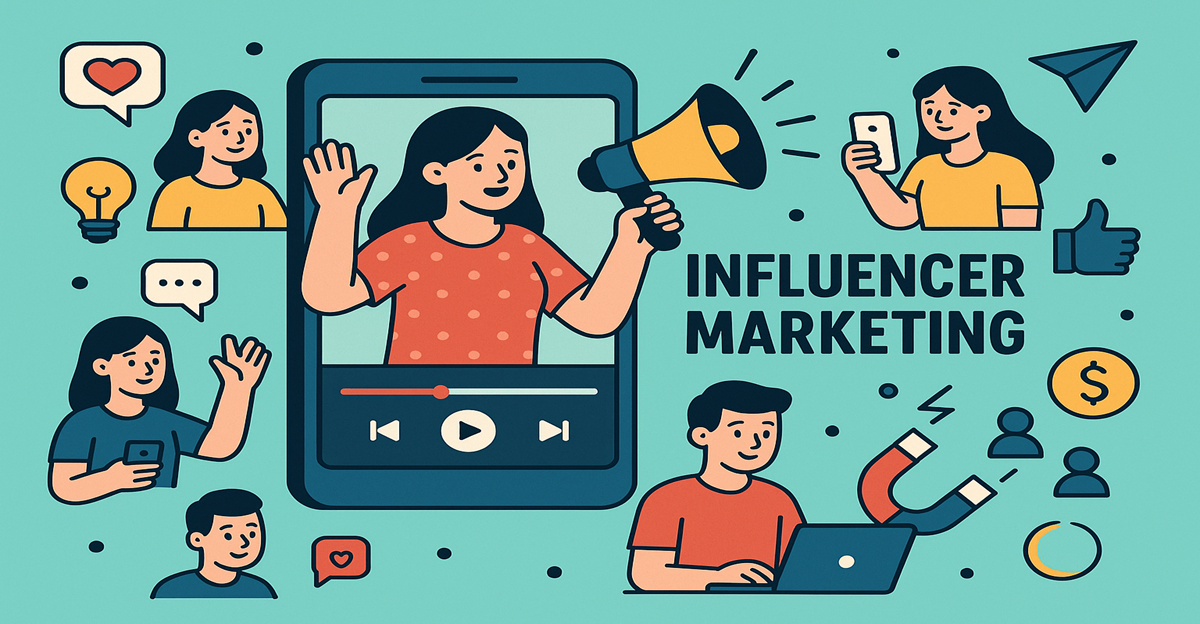Introduction:
As discussed in the opening post https://marketing6s.com/digital-marketing-topics/ there are many types of marketing. For this post we will be examining influencer marketing.
What is Influencer Marketing?
Influencer marketing is like that cool, relatable friend who always knows the best spots in town, and everyone trusts their recommendations. This form of marketing banks on the trust influencers build with their followers. It’s about leveraging their existing relationships and credibility to introduce your brand to a wider audience.
But not all influencers are created equal. You’ve got your macro influencers, who are the Kardashians of the influencer world, with their huge follower counts and broad appeal. Then there are micro-influencers, who might not have millions of followers but have crazy high engagement and niche expertise. And let’s not forget the nano influencers, who are like your super-engaged friend group, small but mighty and very persuasive!
Influencers tap into consumer psychology through authenticity and relatability. They aren’t just selling products; they’re selling trust and experiences. And folks love hearing from someone they feel connected to, even if it’s just through a screen.
This influencer gig might seem like a shiny, new trend, but it’s actually been around for a minute! Back in the day, we trusted recommendations over the grapevine; now, it’s just moved to our social feeds. Understanding this evolution can help us see why influencer marketing is sticking around for the long haul.
Defining Your Brand’s Needs and Goals
Figuring out what you want from an influencer gig starts with looking at your own brand. It’s about knowing your mission and the values you hold dear, and making sure any influencer you team up with is on the same page. You want someone who doesn’t just say nice things about your products but genuinely vibes with your brand’s identity.
Think of successful partnerships like Nike and athletes or fashion brands with style icons. These partnerships show how crucial it is for the influencer’s audience to overlap with your target crowd. You wouldn’t want a tech influencer if you’re marketing eco-friendly beauty products, right?
Pinpointing your target audience’s preferences means you need to dig into data and listen to what they’re buzzing about online. This is where tools come in handy, helping you to map out audience demographics, interests, and behaviors. Crafting a campaign plan that speaks directly to their hearts is key to making those sales.
From the get-go, set clear and measurable goals for your campaign. Are you looking for wider brand visibility, higher engagement, or maybe boosting sales on a new product line? Whatever it is, knowing your endgame will guide every decision in the influencer matchmaking process.
Identifying the Right Influencer: Key Criteria
Choosing the right influencer can be like finding a needle in a digital haystack, but it’s totally doable with the right approach. Start by checking out the influencer’s credibility. Have they worked with brands before, and did those collaborations boost engagement and sentiment? A little online sleuthing goes a long way.
It’s not about the big follower numbers. Focus instead on engagement rates. An influencer with fewer followers but higher engagement might get you more genuine interactions than a mega influencer with low engagement. Quality trumps quantity every time in the influencer game.
Look at how the influencer’s content style meshes with your brand. If your brand is all about minimalism, an influencer who loves vibrant and chaotic aesthetics might not be the best fit. The content should feel seamless and authentic when they talk about your product or service.
There are tons of tools online for vetting potential influencers. Platforms like BuzzSumo and HypeAuditor can give you insights into an influencer’s audience demographics, engagement stats, and even their past brand collabs. Leverage these tools to make informed decisions and don’t be afraid to ask influencers for their media kits for more detailed metrics.
Artificial Intelligence: The New Frontier in Influencer Marketing
Enter the world of AI-generated influencers, the digital creations shaping the future of branding and marketing. These virtual influencers, crafted by artificial intelligence, are gaining traction for their flawless ability to maintain brand consistency and work tirelessly without human limitations.
AI influencers like Lil Miquela and Shudu have successfully amassed fans and followers, showcasing the potential of virtual personalities in building brand narratives. These virtual figures allow brands to control every aspect of their public perception, from aesthetics to messages, with unmatched precision.
While these AI-powered personas come with perks, they aren’t without their challenges. Despite the attention they command, they can sometimes lack the depth of authenticity that real influencers offer. Consumers can be skeptical of these digital beings, questioning their genuine connection to brand messages.
Ethical standing and transparency matter a lot when it comes to AI influencers. Brands need to be open about the nature of these creations to maintain trust with their audience. Ensuring that consumers know they’re interacting with a virtual entity can be key in avoiding backlash and maintaining credibility in the digital marketplace.
Here is a crude example of an AI created influencer that I made to talk about my involvement in GreatLife Worldwide.
Implementing and Measuring Campaign Success
Crafting a winning influencer campaign might feel like juggling flaming swords, but with detailed planning, it’s totally manageable. Start with a solid campaign blueprint. Define your narrative, choose key messages, and plan how influencers will share your story in a way that resonates with them and their followers.
Setting Key Performance Indicators (KPIs) is crucial. These metrics will help you measure success. Are you aiming for enhanced brand awareness, direct sales, or engagement metrics like likes and shares? Clear KPIs ensure everyone’s on the same page about your intended goals.
After your campaign goes live, it’s essential to analyze the data. Look at engagement rates, conversion statistics, and audience growth to evaluate performance. Tools like Google Analytics and social media insights can offer a wealth of information to guide your analysis.
Don’t be afraid to tweak your strategy on-the-fly. If something isn’t working, adapt! The digital world moves fast, and agility can be your best friend here. Taking a flexible approach allows you to capitalize on opportunities.
Building lasting relationships with influencers is key for sustained success. Treat your influencers not just as marketing tools, but as valued partners. Engaged and satisfied influencers are more likely to put in extra effort, which could translate into even more impactful campaigns in the future.
I, Keith Stieneke, studied and implemented marketing strategies for several years, having two different business opportunity tabloids during the early 1990’s. Subscribe to my email list at https://llpgpro.com/6rgtjmck/

